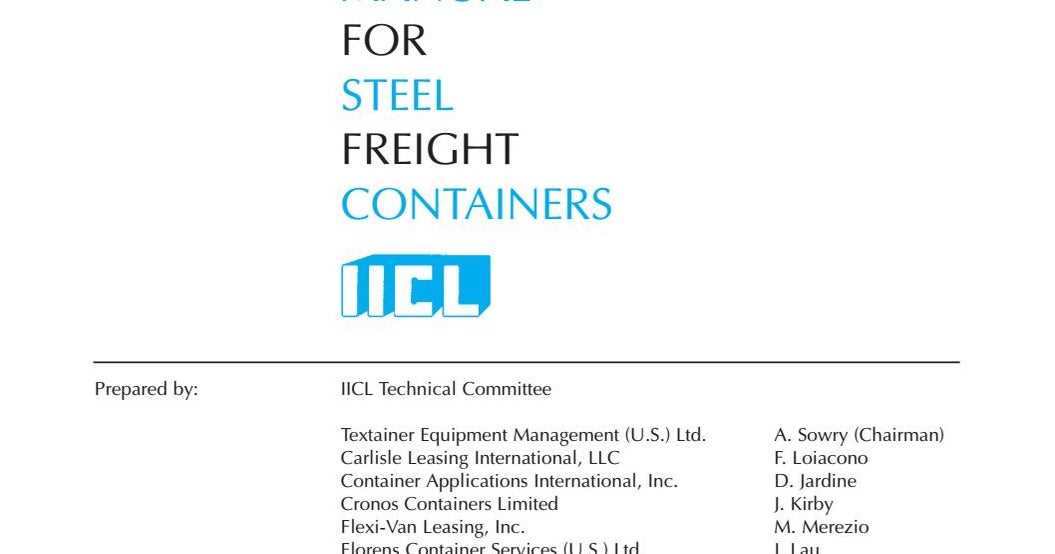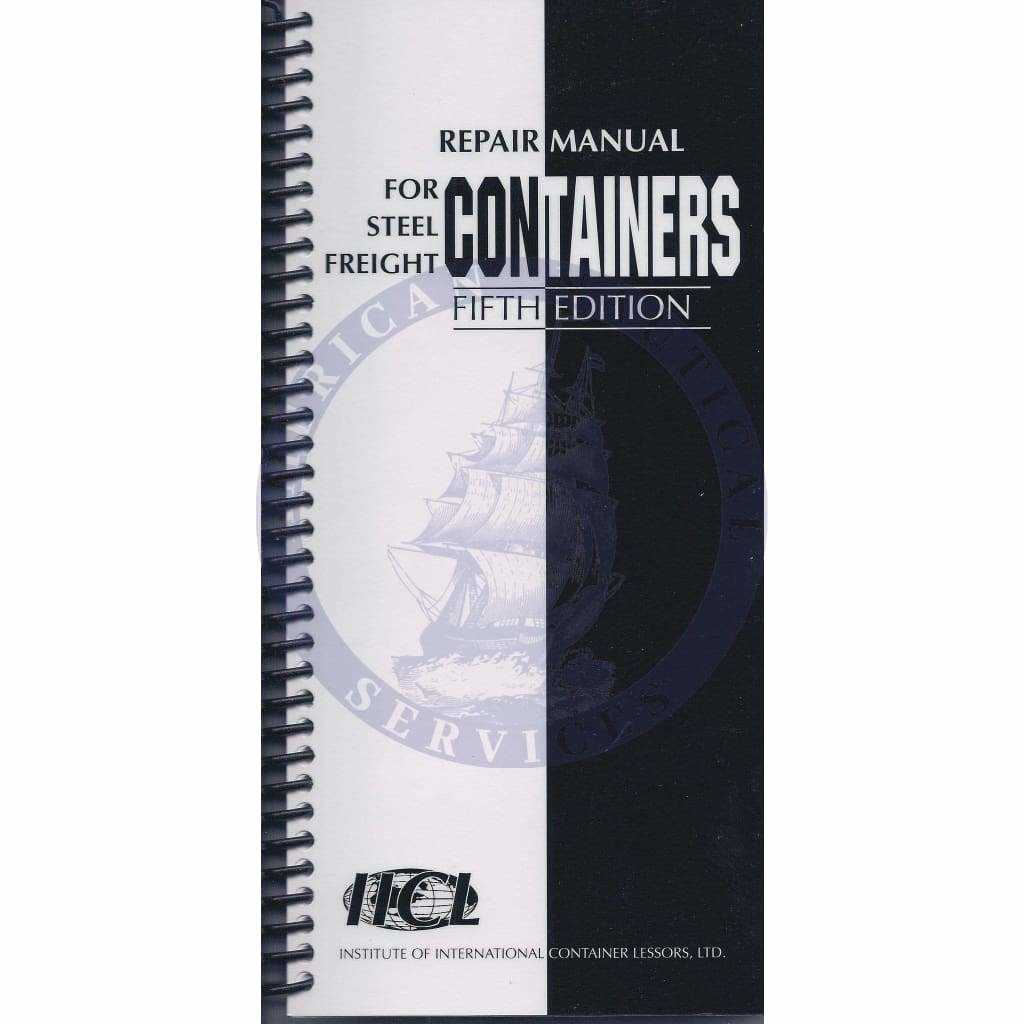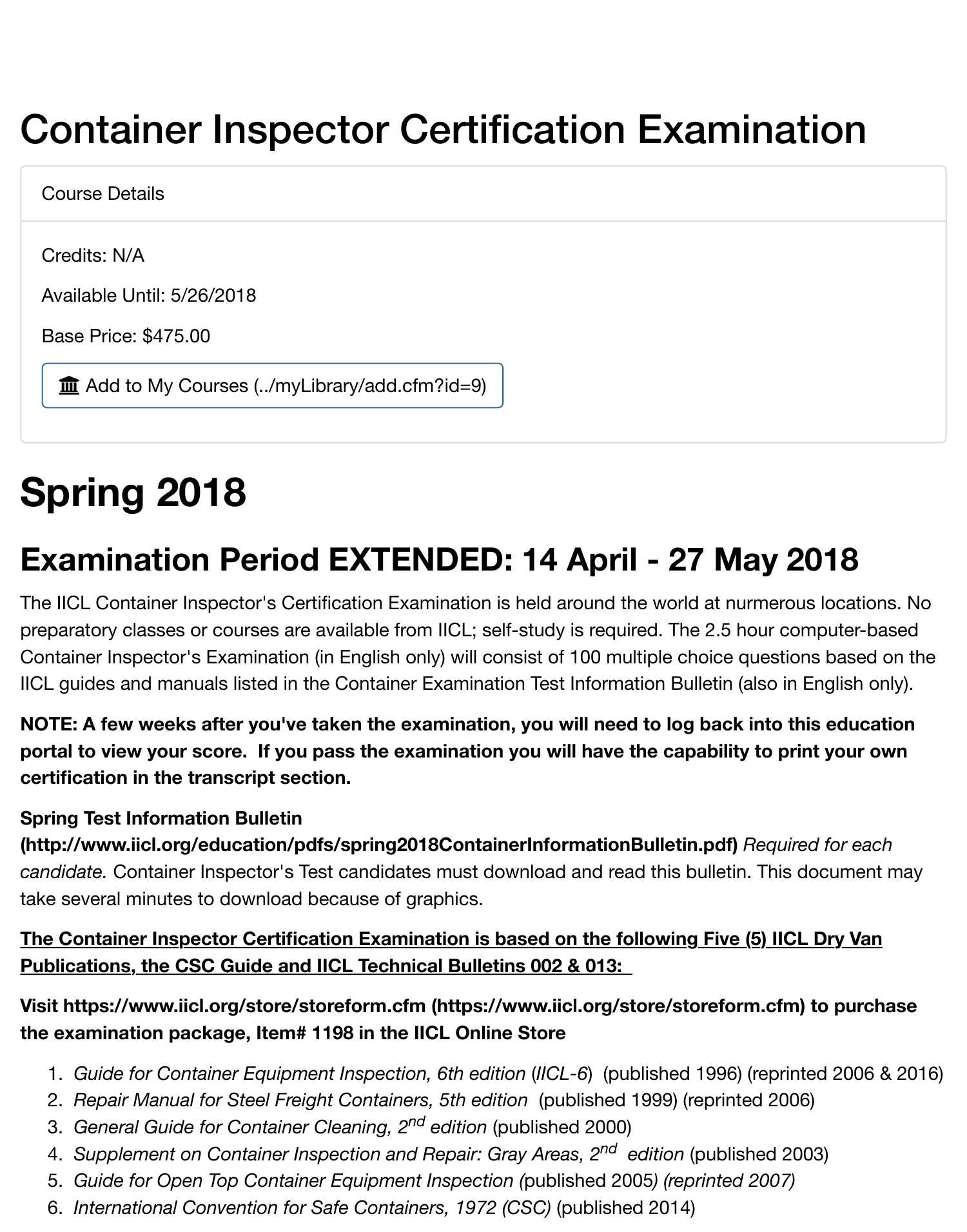Comprehensive Guide to IICL Container Repair

The process of rejuvenating freight units is essential for maintaining efficiency and safety in logistics operations. Proper attention to the structural integrity and functionality of these assets can significantly reduce operational disruptions and enhance service delivery.
In this section, we will explore the vital techniques and practices that ensure the longevity and usability of transport units. Understanding the intricacies of these procedures is crucial for professionals in the field who aim to uphold the highest standards of quality and reliability.
Equipped with comprehensive insights, readers will be empowered to tackle various challenges associated with these assets. This guidance serves as a valuable resource for anyone involved in the upkeep and enhancement of shipping units.
Understanding IICL Standards for Containers
The guidelines set forth by industry authorities play a crucial role in ensuring the quality and safety of transport units used across various sectors. These standards establish a framework for evaluating the condition and durability of such units, promoting longevity and reliability in operations. By adhering to these benchmarks, stakeholders can enhance operational efficiency while minimizing risks associated with transportation and logistics.
Key Principles of Assessment
Central to these guidelines are the principles that dictate the evaluation process. Inspections focus on structural integrity, functionality, and overall condition, enabling operators to identify potential issues before they escalate. Thorough assessments are vital for maintaining safety standards and ensuring that units can withstand the rigors of travel across diverse environments.
Impact on Industry Practices
Compliance with these established norms not only fosters trust among users but also enhances the reputation of service providers. Companies that implement these standards can demonstrate their commitment to quality, thus attracting more clients and driving sustainable practices within the logistics sector. Ultimately, these frameworks serve as a benchmark for excellence, guiding businesses towards improved operational performance.
Common Types of Container Damage

Understanding the various forms of harm that can occur is essential for maintaining the integrity of transport units. Such impairments can arise from a multitude of factors, including environmental influences, operational mishaps, and inherent weaknesses in the structure.
- Structural Compromise: This includes dents, bends, or fractures that affect the overall strength.
- Water Infiltration: Leakage can lead to moisture accumulation, resulting in corrosion and damage to contents.
- Surface Abrasion: Scratches and scuffs caused by contact with other objects can weaken protective coatings.
- Mechanical Impact: Collisions during handling can lead to severe impacts, compromising safety and stability.
- Contamination: Exposure to harmful substances can deteriorate materials and affect the quality of stored goods.
Each type of damage necessitates careful evaluation to determine appropriate corrective actions and preventive measures, ensuring longevity and functionality.
Assessment Techniques for Container Integrity
Evaluating the condition of storage units is essential for ensuring their longevity and reliability. Various methodologies can be employed to systematically identify potential issues and verify the robustness of these structures. Understanding the underlying principles of these techniques is crucial for maintaining operational efficiency and safety.
Visual Inspections
Conducting regular visual examinations allows for the early detection of visible damage or wear. Inspectors should look for signs such as corrosion, cracks, or deformation. This straightforward approach is an effective initial step in assessing structural integrity, as it can reveal obvious faults that require immediate attention.
Non-Destructive Testing (NDT)
Advanced methods like ultrasonic testing and radiography can provide deeper insights without compromising the unit’s integrity. These techniques utilize sound waves or radiation to detect subsurface flaws, enabling a comprehensive evaluation of the material’s condition. Implementing NDT can significantly enhance safety and performance by identifying hidden defects that might not be visible to the naked eye.
Essential Tools for Repair Work
Engaging in restoration tasks requires a diverse set of instruments that facilitate efficiency and precision. Having the right equipment at your disposal not only streamlines the process but also enhances the quality of the outcome.
Basic Hand Tools
- Wrenches: Ideal for gripping, turning, and loosening fasteners.
- Screwdrivers: Essential for driving screws and adjusting components.
- Pliers: Useful for gripping, bending, and cutting materials.
- Utility Knife: Handy for cutting various materials with ease.
Power Tools
- Drill: Vital for creating holes and driving screws efficiently.
- Saw: Perfect for cutting through tougher materials quickly.
- Angle Grinder: Effective for grinding and polishing surfaces.
- Multimeter: Important for measuring electrical parameters accurately.
Equipping yourself with these fundamental tools ensures readiness for a variety of tasks, making the process more manageable and productive.
Step-by-Step Repair Procedures
This section outlines a comprehensive approach to restoring damaged structures, ensuring that each phase is systematically addressed. By following the detailed guidance provided, one can efficiently bring back the integrity and functionality of the units in question.
Assessment and Preparation
The initial step involves a thorough evaluation of the condition to identify any visible damage. This assessment should include checking for structural integrity, identifying any leaks, and evaluating the overall condition of components. Proper documentation of the findings will assist in determining the necessary actions.
Execution of Repair Tasks
Once the assessment is complete, gather all necessary tools and materials required for the job. Begin with the most critical issues identified during the assessment, addressing them methodically. Ensure that all procedures adhere to safety guidelines to minimize risks during the process. After completing each task, conduct a thorough review to confirm that repairs have been executed effectively and meet the required standards.
Quality Control Measures in Repairs
Ensuring the excellence of maintenance tasks is paramount for achieving optimal performance and longevity of structures. Implementing robust evaluation techniques not only enhances reliability but also fosters safety and operational efficiency. Establishing systematic protocols helps in identifying potential flaws early in the process, thereby mitigating risks associated with substandard work.
Inspection Procedures
Regular assessment plays a crucial role in maintaining high standards. Comprehensive inspections should be conducted at various stages, focusing on the integrity of components and adherence to specifications. Employing checklists and evaluation forms aids in documenting findings and facilitating informed decision-making.
Training and Certification

Equipping personnel with the necessary skills is essential for executing quality tasks. Ongoing education and certification programs not only enhance technical knowledge but also instill a culture of excellence. By prioritizing training, organizations ensure that their teams are proficient in the latest methodologies and practices.
Preventive Maintenance Best Practices
Effective upkeep is essential for ensuring the longevity and reliability of any operational asset. By adopting systematic procedures aimed at minimizing unexpected failures, organizations can enhance performance, reduce costs, and extend the life cycle of their equipment. A proactive approach to maintenance fosters an environment where issues are identified early, ensuring smooth and efficient operations.
Routine Inspections
Regular assessments play a critical role in maintaining functionality. Scheduled check-ups should encompass all vital components, allowing for the early detection of wear or potential faults. Thorough inspections should focus on critical areas, ensuring that any irregularities are addressed promptly, thus preventing more significant complications down the line.
Documentation and Record Keeping
Maintaining accurate logs of maintenance activities is vital for understanding the operational history of each asset. Detailed records provide insights into previous issues, repairs, and replacements, aiding in the identification of patterns that may necessitate adjustments to maintenance strategies. This practice not only enhances accountability but also ensures that knowledge is preserved for future reference.
Cost Considerations for Repairs
Understanding the financial aspects associated with maintenance and restoration is essential for effective budgeting and decision-making. Various factors influence the total expenditure, which can vary significantly based on the scope and nature of the work required.
- Material Costs: The prices of necessary components can fluctuate, impacting the overall budget. It’s important to source quality materials to ensure longevity and performance.
- Labor Expenses: Skilled professionals may charge differently based on their expertise and the complexity of the tasks. Comparing rates can lead to more informed choices.
- Timeframe: Urgent repairs may incur additional costs due to expedited services. Planning maintenance during off-peak times can be more economical.
- Inspection Fees: Initial assessments can help identify potential issues early, although they may add to upfront costs. Regular inspections can ultimately save money by preventing larger problems.
By considering these elements, individuals and organizations can better manage their financial resources and ensure that all necessary work is completed efficiently and effectively.
Environmental Regulations and Compliance
Understanding and adhering to environmental standards is crucial for maintaining operational integrity and sustainability in any industry. Compliance ensures that practices are aligned with legal requirements and promotes responsible management of resources, which can significantly reduce ecological impacts.
Organizations must stay informed about relevant legislation and best practices to mitigate risks associated with environmental liabilities. The following table outlines key regulations and their implications for businesses operating within this framework:
| Regulation | Description | Compliance Requirements |
|---|---|---|
| Resource Conservation and Recovery Act (RCRA) | Governance of waste management and treatment standards. | Proper classification, treatment, storage, and disposal of hazardous waste. |
| Clean Water Act (CWA) | Regulation of discharges into navigable waters. | Obtaining necessary permits and monitoring water quality. |
| National Environmental Policy Act (NEPA) | Requirement for federal agencies to assess environmental effects of their proposed actions. | Conducting Environmental Impact Statements (EIS) when necessary. |
Adhering to these standards not only fosters a safer environment but also enhances a company’s reputation and can lead to financial benefits through improved efficiency and reduced liability costs.
Future Trends in Container Repair
The landscape of maintenance and restoration in the transport industry is undergoing significant transformation. As technologies evolve, practices are shifting towards more efficient and sustainable methods. This section explores the anticipated advancements that will shape the future of refurbishment in this sector.
Innovative Technologies
Emerging technologies are set to revolutionize the way maintenance is conducted. Key innovations include:
- Automation: The use of automated systems for inspection and diagnostics is expected to enhance precision and speed.
- Advanced Materials: Incorporating lightweight and durable materials will likely improve longevity and reduce maintenance needs.
- Data Analytics: Utilizing big data for predictive maintenance can help identify issues before they escalate.
Sustainable Practices
Environmental considerations are becoming increasingly important. Future practices will likely emphasize:
- Recycling: The implementation of recycling programs for damaged components will reduce waste.
- Energy Efficiency: Strategies aimed at minimizing energy consumption during restoration processes will gain traction.
- Green Certifications: Businesses may seek certifications that demonstrate their commitment to sustainable practices.